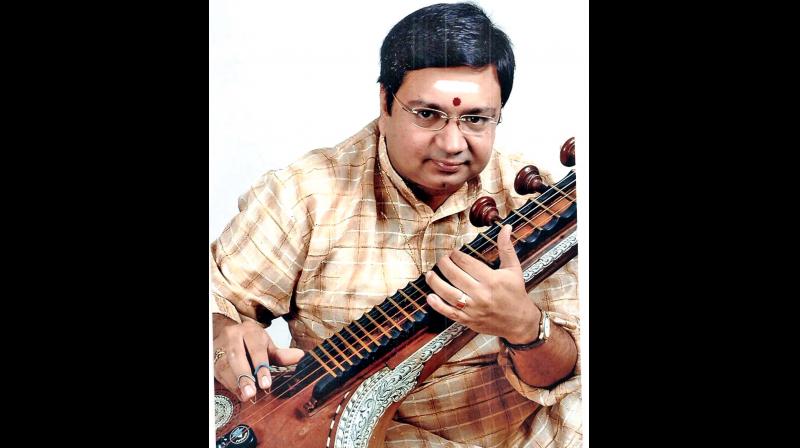Of art and music: A Vainik who creates music

He was the youngest artiste to represent our country at the Festival of India in the then USSR in 1987. Hailing from a family with an artistic background and a list of achievements, this veena artiste is a winner of various awards, titles and fellowships from the Ministry of Culture, Government of India.
He is the only artiste, who has performed jugal bandhis with santoor, sarod and sitar artistes of North India and makes full use of the 31/2 octaves in the veena. He is none other than veena artiste B. Kannan, nephew of Dr Padma Subramanyam, an internationally reputed dancer and research scholar. Certainly, this Vainik, a traditionalist, who springs from the devoted and religiously bent family, stands out.
His gentle smile always proclaims his genteel demeanor, and he would be reckoned as an artiste, carving a niche for himself in the arena of music. Music Academy deputed him as an examiner for SIFAS, Singapore. Recently in June, 2017, he was invited by the National Arts Council, Govt. of Singapore to be in the jury for the National Indian Music Competition.
He is the trustee-secretary of Nrithyodaya, Chennai, Bharata-Ilango Foundation for Asian Culture and director of K. Subrahmanyam Memorial Trust.
Excerpts from an interview with him:
I organise ‘Veena Utsav’ in the city every year. This year more than 200 artistes from all over the globe are to perform over 15 days at Narada Gana Sabha, Chennai from November 6.
Q: About your USSR trip:
I accompanied my aunt for the festival of India in USSR. During the inaugural week, on the day of my concert, a heat wave was predicted and hence I decided to play Amrithavarshini, ragam tanam and Dikshitar's immortal compositions — Ananda amirtha varshini, praying to musical trinity and Kanchi Mahaswami. And yes, there was heavy downpour, when I finished the kriti, the audience was elated.
The same magic happened in Japan, on the occasion of Pukuoka Asian Cultural Prize Award Ceremony, where my aunt was awarded, and also at Muthuswamy Dikshatar’s Samadhi at Ettayapuram. This only proves that songs can be considered as the fountainhead of sublimity of Sangeetha and in each one of them there is certainly some divinity.
Q: What gave a flying start to your musical concerts?
Certainly the cultural environment at home with my aunt Padma Subramaniyam, my father Balakrishnan, a reputed documentary filmaker, and mother Shyamala Balakrishnan, a well-known singer and research scholar in music. Paternal grandfather Subramanyam, who was a well known director, and my paternal grand mother Meenakshi, who was also a composer and vainika. Our house always reverberated with the sound of music and ankle bells. I should admit that Carnatic music has been my underlying core, an abiding passion and an integral part of living itself. For me, it is art for art's sake.
Q: What do you have to say about the technical aspect of playing the veena?
I integrate the best of veena technique. The outpouring from the instrument should approximate of ‘vocal artistry’, I apply the technique to realise this effect, as far as possible.
Q: What is your take on practice?
Like vocal music, there is akara practice in veena. All the alankarams have to be learnt swara wise and akhara wise. This has to be practised in all sampoorna melakartha raga, which is a a very important grip on laya.
I remember my gurus — Vasantha Krishnamoorthy, R. Pichumani Iyer and Dr. S. Balachander, who would always insist that the concealed intricacies in kirtanas and alapanas could be gained by the constant hearing of “good whole some music”. I religiously follow this.

